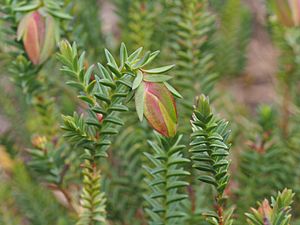Mogumber bell facts for kids
Quick facts for kids Mogumber or Narrogin bell |
|
|---|---|
 |
|
| Darwinia carnea leaves and inflorescence (not fully open) | |
| Conservation status | |
| Scientific classification | |
| Genus: |
Darwinia
|
| Species: |
carnea
|
The Darwinia carnea, often called the Mogumber bell or Narrogin bell, is a special plant from the Myrtaceae family, which also includes eucalyptus trees. This plant grows only in the south-west part of Western Australia. It's a small bush with thin, V-shaped leaves. Its flowers grow in groups, surrounded by colorful leaf-like parts called bracteoles.
This plant is unique because it's the only "bell-flowered" Darwinia that doesn't grow in the Stirling Range National Park. You can find it in small, separate groups near the towns of Mogumber and Narrogin, which is how it got its common names.
Contents
What the Mogumber Bell Looks Like
The Darwinia carnea is a shrub that can grow from about 0.2 to 2.0 meters (0.7 to 6.6 feet) tall. Its leaves grow in pairs, with each pair at a right angle to the one above it. The leaves are smooth and hairless (this is called glabrous). They are shaped like a line or a narrow spear, usually 6 to 10 millimeters (0.2 to 0.4 inches) long and about 1 millimeter (0.04 inches) wide. They are also roughly V-shaped when you look at them from the side.
The flowers grow in groups of 10 to 14 at the ends of the branches. Each group is surrounded by large, smooth, egg-shaped bracteoles. These bracteoles can be yellowish-green to pinkish-red and grow up to 30 millimeters (1.2 inches) long. They form a bell-like shape around the flowers. The individual flowers inside this "bell" are shaped like tubes. They have blunt, egg-shaped petals that are about 4 millimeters (0.16 inches) long and 2 millimeters (0.08 inches) wide.
This plant usually flowers between October and December. After flowering, it produces small, dry fruits that are like tiny nuts.
There are two main types of Darwinia carnea. The one found near Mogumber grows taller, up to 2.0 meters (6.6 feet). It also has bigger flowers and different colored bracteoles compared to the type found near Narrogin.
How the Mogumber Bell Got Its Name
The first official description of Darwinia carnea was written by a botanist named Charles Gardner. He published his findings in 1923 in a scientific journal called Royal Society of Western Australia.
Gardner collected the very first sample of this plant, known as the type specimen, between Mogumber and New Norcia. The second part of its scientific name, carnea, comes from a Latin word meaning "flesh." This refers to the flesh-like color of the bracts (the colorful leaf-like parts) around the flowers.
Where the Mogumber Bell Lives
The two different types of Darwinia carnea are found about 250 kilometers (155 miles) apart. There is only one small group of these plants near Narrogin. Near Mogumber, there are three small groups. All of these plants grow on private land.
They prefer to grow on gravelly hilltops or on rocky areas called lateritic breakaways. These areas are often part of a heathy woodland, which is a type of forest with many small shrubs. To help protect this rare plant, some groups have been moved to nature reserves. This process is called translocation.
Protecting the Mogumber Bell
The Darwinia carnea is a very rare plant. The Western Australian Government's Department of Parks and Wildlife has listed it as "Threatened Flora." This means it's a plant that needs special protection. A plan has been created to help it recover and grow stronger.
The Australian Government also lists it as "Endangered" under the Environment Protection and Biodiversity Conservation Act 1999 (EPBC Act). This means it's at a very high risk of disappearing forever.
It's thought that this plant has always been rare. There's a story from the 1980s about a botanist who found the plant on a farmer's land. The botanist wanted the farmer to protect the plant by fencing off a large area, but didn't say exactly where the plant was. The farmer couldn't fence such a big area. Later, when botanists returned, they couldn't find any Darwinia carnea plants there. This shows how important it is to know where these rare plants are and to protect them carefully.
Growing the Mogumber Bell in Gardens
Darwinia carnea is known in some gardens, but it can be tricky to grow. It needs soil that drains water very well, and it also needs some protection from direct sunlight or harsh weather.
You can try to grow it from cuttings, which are small pieces of the plant. However, it's often more successful to grow it by grafting. This is a special technique where a piece of Darwinia carnea is joined onto the root system (called the rootstock) of another plant, like the Darwinia citriodora. This helps the plant grow better.
Images for kids
-
D. carnea growing in Kings Park




